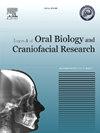Evaluation of dentin thickness preservation and the efficiency of instrumentation between traditional and guided endodontic access in mandibular central incisors
Q1 Medicine
Journal of oral biology and craniofacial research
Pub Date : 2025-05-08
DOI:10.1016/j.jobcr.2025.04.011
引用次数: 0
Abstract
Introduction
Tooth substance loss during endodontic treatment is a major concern, especially in mandibular incisors due to their minimal tooth volume. Template-guided access cavities help preserve dentin and improve instrument centering. This in vitro study compares remaining dentin thickness (RDT) and centering ability of rotary instruments using both conventional and template-guided approaches in mandibular incisors.
Objective
Comparative in vitro CBCT study on remaining dentin thickness and centering ability of rotary instrumentation in mandibular incisors using conventional vs. template-guided access cavity preparation.
Methodology
Pre-treatment CBCT scans were taken of 80 mandibular incisors, to evaluate the existing dentin thickness and these were then divided into 2 groups of 40 teeth each. Conventional endodontic access cavities were made in Group −1, and guided access openings were done in Group – 2. Post-operative CBCT scans were taken to measure the RDT canal centering ability of each approach.
The data was examined using a one-way analysis of variance, followed by Tukey's post-hoc test for multiple pairwise comparisons, with a significance level set at p < 0.05.
Results
The mean RDT was significantly higher in the group where a template-guided access opening was done. The statistical difference for RDT amongst both the experimental groups was highly significant at the Cemento-Enamel Junction and 9 mm from the root apex. Statistically significant results were obtained 6 mm level and insignificant result was obtained at 3 mm level from root apex. No significant differences in the centering ability ratio were observed between the Traditional Endodontic Cavity (TEC) and Guided Endodontic Cavity (GEC) at any level.
Conclusion
Pericervical dentin was preserved more in guided access cavity preparation. The design of the access cavity preparation did not impact the centering ratio of the instruments used for shaping the root canals.

传统与引导下中切牙根管通路的牙本质厚度保存及内固定效果评价
牙髓治疗过程中牙物质流失是一个主要问题,尤其是下颌切牙,因为它们的牙体积很小。模板导向的通道腔有助于保护牙本质并改善仪器定心。本研究比较了下颌门牙常规入路和模板引导入路旋转器械的剩余牙本质厚度(RDT)和定心能力。目的比较常规与模板引导下门牙入路预备牙本质剩余厚度及对中能力的体外CBCT对比研究。方法采用CBCT扫描治疗前80个下颌骨切牙,评估牙本质厚度,并将其分为2组,每组40个牙。−1组制作常规根管通道腔,- 2组制作引导通道开口。术后采用CBCT扫描测量各入路的RDT管对中能力。采用单向方差分析对数据进行检验,随后采用Tukey事后检验对多个两两比较进行检验,显著性水平设置为p <;0.05.结果采用模板引导下通路开放组的平均RDT显著高于对照组。两组间的RDT在牙骨质-牙釉质交界处和离根尖9mm处有显著的统计学差异。在根尖处6 mm处结果具有统计学意义,在根尖处3 mm处结果不显著。传统牙髓腔(TEC)与引导牙髓腔(GEC)在任何水平上的定心能力比均无显著差异。结论导入腔预备术能更好地保留颈周牙本质。预备通道的设计对根管成形器械的对中比例没有影响。
本文章由计算机程序翻译,如有差异,请以英文原文为准。
求助全文
约1分钟内获得全文
求助全文
来源期刊

Journal of oral biology and craniofacial research
Medicine-Otorhinolaryngology
CiteScore
4.90
自引率
0.00%
发文量
133
审稿时长
167 days
期刊介绍:
Journal of Oral Biology and Craniofacial Research (JOBCR)is the official journal of the Craniofacial Research Foundation (CRF). The journal aims to provide a common platform for both clinical and translational research and to promote interdisciplinary sciences in craniofacial region. JOBCR publishes content that includes diseases, injuries and defects in the head, neck, face, jaws and the hard and soft tissues of the mouth and jaws and face region; diagnosis and medical management of diseases specific to the orofacial tissues and of oral manifestations of systemic diseases; studies on identifying populations at risk of oral disease or in need of specific care, and comparing regional, environmental, social, and access similarities and differences in dental care between populations; diseases of the mouth and related structures like salivary glands, temporomandibular joints, facial muscles and perioral skin; biomedical engineering, tissue engineering and stem cells. The journal publishes reviews, commentaries, peer-reviewed original research articles, short communication, and case reports.
 求助内容:
求助内容: 应助结果提醒方式:
应助结果提醒方式:


